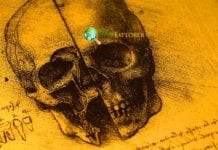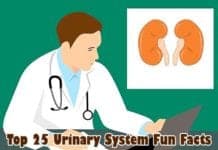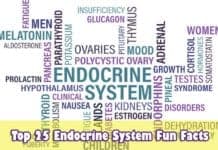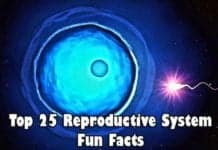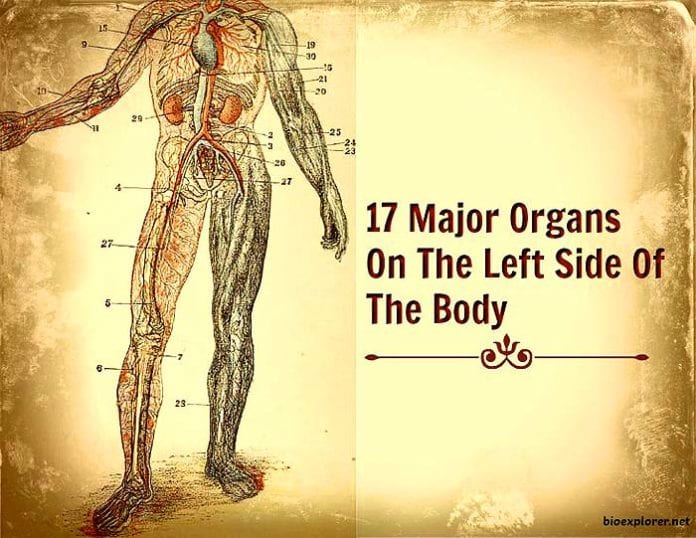
Organs on left side of body: The human body is known to display symmetry. When you divide the body into two, each side would be the exact copy of the other. While this is true in the case of the external human body, the organization of the internal organs is different.
The bone structure, as well as the shape and distribution of the organs inside, are different.
Many organs are located in or close to the central plane; however, some organs are either paired (have left and right sides) or are exclusively located on one side.
What organs are on the left side? In this article, discover the 17 major organs on the left side of the body and learn how they function with their paired organ and with other parts of the whole.
Let’s explore with a closer look.
Table of Contents
Organs On The Left Side Of The Body
Here are the major organs on the left side of the body:
1. Left Hemisphere of the Brain
In humans, as well as other animals, the brain is considered to be the most complex organ. The brain is divided into two halves known as hemispheres.
- These two hemispheres (left and right) are responsible for controlling the movement and receiving sensory inputs from the opposite side of the body. In particular, the left hemisphere is considered to be the brain’s practical, rational, and logical side.
- Aside from that, it is responsible for responding to verbal instructions and differentiating objects.
![]()
2. Left Eye
The eyes are one of the many paired organs in the body. Considered to be the windows to the soul, the eyes function for the capture and focus of light into sensory receptors.
- The energy will be transformed into neural signals and sent to the brain. According to studies, more than 30% of the world population is left-eye dominant.
- Nevertheless, such dominance is not persistent as it depends on the line of the path in which the individual may see an object.
![]()
3. Left Ear
The ears are one of the body’s most advanced and sensitive organs.
- Aside from its primary function of transmitting and conversion of sound waves to the brain through its external, middle, and inner layers, the ears also function in the maintenance of the body’s balance or equilibrium.
![]()
4. Left Anterior Naris
The anterior nares are the external openings of the nose (or nostrils) into the nasal cavity.
- Collectively, the nose and the nasal cavity comprise the upper parts of the human respiratory tract.
- As such, the anterior nares functions to allow the exchange of gases (i.e., inhalation and exhalation) to and from the environment.
![]()
5. Left Breast
Another paired organ in this list is the breasts located at the chest. Males and females have glandular tissues in their breasts; however, they are far more developed in females.
- This development is because these tissues start to develop during puberty as a response to the release of female hormones. The mammary glands in females will produce milk only after childbirth.
- Aside from the changes in the size and appearance of the breasts, changes in the color of the areola also occur.
![]()
6. Left Lung
Also one of the paired organs in this list, the lungs are sponge-like and butterfly-shaped organs that facilitate the respiration process.
- The right and left lungs are divided into the superior, inferior, and middle lobes. Interestingly, the left lung is smaller in size (the left is narrower; the right is wider) than the right lung.
- This arrangement is anatomically made to accommodate and give space to the heart, which is situated on the left side of the chest cavity.
![]()
7. Heart
To be specific, the heart is not correctly located on the left side of the body. Instead, it is found in the body’s midline (in the thoracic cavity, just above the diaphragm).
- However, about 2/3 of the heart mass is situated on the left side, while only 1/3 is found on the right side.
- As an organ, the heart functions to pump blood through a network of blood vessels in the cardiovascular system. Interestingly, the heart also has left, and right sides that are separated by a thick wall known as the septum.
![]()
8. Left Appendicular Skeleton
The human skeleton, composed of bones, functions as the body’s internal framework. In general, there are 270 bones present at birth, but they gradually decrease to 206 by adulthood, as some of them become fused structures.
- The bones present on the left shoulder girdles (i.e., clavicle and scapulae) are known to be the body’s appendicular skeleton.
- Aside from these bones, the bones of the left upper arm, left forearm, left hand, metacarpals, and phalanges, left coxal bones (i.e., ischium, ilium, and pubis), left thigh, left leg, left tibia and fibula, left tarsals and phalanges are also found in the left side of the body.
![]()
9. Spleen
Located above the stomach and in the upper left portion of the stomach, the spleen is considered to be the largest organ in the lymphatic system.
- Located above the stomach and in the upper left portion of the stomach, the spleen is considered to be the largest organ in the lymphatic system. The spleen mainly functions for the maintenance of the balance of the lymphatic system.
- The spleen has red pulp tissues that work in the filtration of blood and eradication of damaged erythrocytes (red blood cells), and white pulp tissues that aid in the protection of the body against infection.
- Despite its role in the body, interestingly, humans can possibly live even without it.
![]()
10. Pancreas
Located behind the upper left abdomen and just behind the stomach, the pancreas is a flat, pear-shaped organ with two primary functions: endocrine and exocrine.
- Regarding its endocrine function, the pancreas functions to regulate blood sugar. To do this, the pancreas produces the hormones insulin and glucagon.
- Regarding its exocrine function, the pancreas aids in the digestion process by producing enzymes that break down carbohydrates, proteins, lipids, and nucleic acids.
![]()
11. Stomach
Located on the upper left side of the abdomen, the stomach is one of the most critical organs during digestion.
- The stomach receives food from the mouth and esophagus. The stomach produces the necessary enzymes and acids that break down food.
- It then contracts occasionally to enhance the digestion process further.
![]()
12. Left Kidney
The kidneys are bean-shaped organs on both sides of the spine, below the ribcage, and at the back of the abdomen.
- These organs have the primary function of filtering the blood and removing the associated wastes from it. Aside from that, the kidneys function to maintain the balance of fluids and electrolytes.
- The average size of one kidney is about 4-5 inches long.
![]()
13. Left Adrenal Gland
Located on top of each kidney, the adrenal glands are triangular organs that are 1.5 inches to 3 inches long (ad-near & renes-kidneys).
- Composed of two parts, the medulla and cortex, each adrenal gland is responsible for producing the hormones that regulate the immune system, metabolism, blood pressure, and even response to external factors.
![]()
14. Left Ureter
Another paired organs in this list are the ureters which are located on the abdomen (upper half) and the pelvic area (lower half).
- These muscular ducts function to transport urine from the pair of kidneys to the urinary bladder. In adults, the average size of the ureters is about 10 to 12 inches long.
- These muscular ducts comprise contractible fibrous muscles and a mucous coat.
![]()
15. Left Ovary
The ovaries are known to be a pair of almond-shaped organs that are one of the most important parts of the female reproductive system.
- The ovaries are responsible for the secretion of the female hormones progesterone and estrogen. The left and right ovaries take a turn in releasing eggs monthly.
- Aside from that, the ovaries are responsible for the production of eggs that are to be fertilized by the sperm cells during sexual intercourse.
![]()
16. Left Testis
Also known as testicles, the testis (plural: testes) is one of the two oval-shaped organs of the male reproductive system.
- Hanging outside the body in the pelvic region and contained in the sac known as the scrotum, the testes function for the production and storage of sperm cells and testosterone.
![]()
17. Large Intestine
Considered to be the final portion of the gastrointestinal tract, the large intestine is the organ that is responsible for the absorption of water, minerals, and vitamins, while, at the same time, converting food into fecal matter.
- Regarding length, the large intestine is shorter than the small intestine.
- It is divided into different parts, three of which are located on the left side of the body: descending colon, sigmoid colon, rectosigmoid colon.
![]()
Some Exceptions
According to anatomical studies, our genetic makeup is what determines the side on which side of the body should the organs be located. Interestingly, about 0.01% of the world’s population is characterized by the condition known as Situs Inversus.
People born with the said congenital condition have abnormal positioning of visceral organs. In other words, their visceral organs are located on the opposite side of the body.
- Aside from that, this condition is also observed in “mirror image” twins that happen because of the late splitting of the fertilized embryo during pregnancy.
- These twins have opposite character traits such as handedness, dominance in the brain hemisphere, and asymmetrical features.
- Examples of this condition include the wrong positions of the left atrium of the heart and left lung (they are located on the right side instead) and the wrong position of the liver (it is positioned on the left side of the abdominal cavity).
Now that you have known the organs on the left side of the body, can you guess which are located on the right?
![]()




